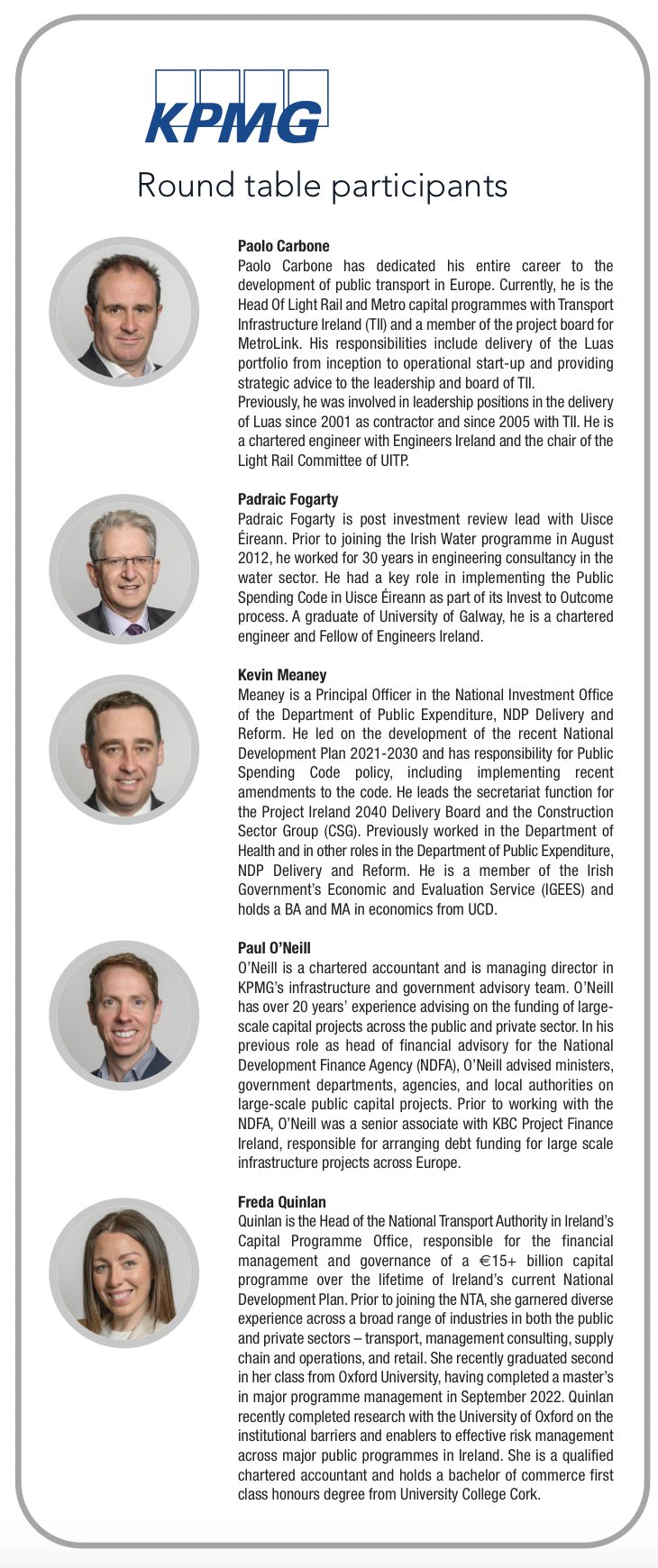Updating the Public Spending Code to enhance the delivery of capital projects

Following the recent changes to the Public Spending Code (PSC) and ahead of the publication of the Infrastructure Guidelines which will supersede it, KPMG Ireland hosted a round table discussion with key public service and semi-state bodies and the Department of Public Expenditure, NDP Delivery and Reform to discuss how Ireland might enhance the delivery of capital projects.
What has the recent update to the Public Spending Code meant for the delivery of capital projects?
Paolo Carbone
Having a process that is structured and applies to every sector across the Public Service is an advantage that makes projects more transparent to the public and enables a consistent approach. In other jurisdictions, in the absence of a Public Spending Code, I have observed significant disparities in the extent of project appraisal. Streamlining decision-making will make the process leaner. From TII’s perspective, it will not reduce the workload significantly, primarily because our preliminary business cases are quite detailed, but it will remove some elements of the process and that is obviously a positive development.
Padraic Fogarty
Having external assurance for major projects at one rather two gates should reduce timelines by at least six months, so that is welcome. Having the external assurance at gate one rather than gate two is appropriate because it is at a point in the project where there is a preferred option, and, typically, enough detail to carry out a review prior to getting into substantial expenditure on the project. Government consent is now required only at gates one and three and that should also help in terms of reducing timelines for the delivery of critical infrastructure projects across the State.

Kevin Meaney
The review into the Public Spending Code started in 2022 and the Department was keen to hear the views of all the relevant sectors as it is difficult for us to see the length of time it takes for projects to be approved within sectors. This included the perspectives of senior officials from across the government departments with significant public expenditure, and personnel from the units that undertake spending reviews on behalf of the ministers. The timeline we were provided with from sectors, for the strategic assessment, was between three and four months just to get a project approved internally. DPENDPDR took that on board and acknowledged that a significant amount of time was taken up with internal processes and was the reasoning behind removing that decision gate. For consideration at decision gate two, the feedback was that removing the second round of external reviews could possibly save six months or more. Indeed, the feedback that we are receiving is that the changes made could save up to 10 months on a major project.
Paul O’Neill
The changes are welcome and have been well received, particularly collapsing the Strategic Assessment Report into the Preliminary Business Case as they tended to overlap. The removal of government approval at pre-tender stage is welcome as project delivery timelines tend to come under more scrutiny at this point and key stakeholders/project managers are keen to drive on and get projects moving into the tender phase, whereas there tends to be more flexibility at the planning stage. The removal of the major project review at the final business case is also welcome as we have found it can create uncertainty in the wider market around delivery risk and the potential for project changes. However, it is also about striking the right balance on the changes to the Public Spending Code as the checks and safeguards are still necessary.
“Given the scale and breadth of the National Development Plan, we need to be very cognisant of the need to capture the wider international market.” Paul O’Neill
Freda Quinlan
This most recent update to the Public Spending Code illustrates that the Government is committed to an agile approach to project delivery that adapts to changing conditions. The announcement that government is no longer the approving authority for major projects helps to enshrine the responsibility and accountability with those charged with day-to-day oversight and delivery. It also optimises decision-making in the front-end, helping to move towards governance that is value adding as opposed to procedural. It also helps to ensure greater certainty in terms of front-end timelines and that is particularly important in a public sector context. There are reduced cost implications, and it is important that we are careful to optimise the current timelines in the face of future inflationary impacts driven by delayed approvals.

How has the increase in the major project threshold impacted capital projects below the threshold?
Freda Quinlan
It is dependent on both the delivery agencies and the approving authority, but the NTA, for example, has a robust set of project approval guidelines across different bands of investment to ensure that the governance of these schemes is appropriate to the level of investment, and we have undertaken work to streamline our activities in that regard. Ultimately, timeliness is crucial. The public and political system want to see delivery. In that respect, this is a positive step forward.
Paolo Carbone
TII’s light rail and metro programme schemes are generally above the threshold, but it helps with projects such as our fleet supply programme. We now have a more appropriate scaling of future competitions for vehicles which is an important factor because it gives the market greater volume. Removing a barrier that is beyond our control is reassuring for the market.

Paul O’Neill
Practically, it provides more flexibility and discretion to sponsoring departments and agencies and should allow project timelines to be mapped out more clearly. Though we still need to ensure the oversight is in place so that the changes to the Public Spending Code have the desired effect to drive more efficiencies and accelerate project delivery timelines. This is something that we must be mindful of.
Padraic Fogarty
There is a particular benefit for those projects between €100 million and €200 million, in that the external assurance process will no longer apply. Overall, I would say that the process required at each stage of a project remains the same from a delivery perspective and the focus is on what happens at each of the decision gates. In terms of the remaining gates that involve external approvals, there may be further measures that can be taken to improve the efficiencies to achieve quicker delivery of projects.
“I regularly speak with international companies, and they are adamant that they will not sign contracts with a limitation of liability.” Paolo Carbone
Kevin Meaney
The full approvals process is still in place for projects below the increased threshold, and while some of the full requirements may not be requested, the decision gates are still points at which decisions need to be taken. However, this can now happen within a sector rather than requiring an external viewpoint. There are sectors that have a lot of those projects who have very good processes in place while there is still some work to do in others, which more commonly have less of these projects of scale. From the feedback of sectors, particularly transport, it was clear that major €1 billion plus programmes broke into many projects in the range from €100 million to €200 million. A significant advantage of the reformed Public Spending Code is that once these programmes of substantial expenditure are approved at the preliminary stage, these projects of between €100 million and €200 million can advance with greater certainty to the procurement stage, and therefore, it gives that bit of certainty to the market.
How significant is the condensed project approval process to the timely delivery of major capital projects and, ultimately, aligned government policy objectives?
Kevin Meaney
There is still significant external focus on the preliminary business case stage, and the Department feels that this is the time to catch mistakes and implement mitigations. It is intended to strike a balance between good rigorous assessment of projects and while ensuring timeliness; these are big projects and if they do go wrong, they can go badly wrong. We are trying to ensure that we are not overtly delaying the process and striking the right balance between getting through the right process and getting to market as soon as we can, while mitigating risks at an early stage.
Paolo Carbone
I would like to see more engagement on the incremental assurance because approving a preliminary business case for TII projects still takes between 12 and 18 months. While the preliminary business case merely allows an application for planning to be made, at that point it will have required most of the money it takes to get to planning. TII has developed a cost forecasting mechanism – applied in the first instance to MetroLink project – with multi-stage estimates and verification, alongside an expert judgment panel complete with international perspective. I am a believer in the process of external assurances but there is some work to be completed to avoid duplication; asking the same questions up to three times.
Paul O’Neill
We talk about the streamlining of some governance oversight, but it is about achieving a balance. The preparation of business cases is not about creating an industry; we need to continue to challenge and question however we can create and deliver even more efficiencies and not produce overly complex and detailed reports just for the sake of it. Similarly, we are observing the fact that often preliminary business cases are still not happening early enough in the project lifecycle, and this is adding to the delays.
Freda Quinlan
For the NTA, in terms of achieving greater efficiency, encapsulating elements of the strategic assessment report within the preliminary business case has been a great step forward because we struggled at that stage with optioneering given that work had already been completed and embedded within our transport strategies. In terms of streamlining the approval process, it should take an important step forward in focusing on scrutiny and validation of decisions. This will avoid the illusion of objectivity and transparency and instead focus on what decisions have been taken and if they are the right ones.
Padraic Fogarty
While there are benefits in condensing the project approval process, I would say that some of the changes appear to be cosmetic without adding any real value. In particular, I would like to highlight the combining of stages five and six of the project lifecycle. As the Project Completion report and Ex-post Evaluation report will need to be prepared independently of each other, there appears to be no real benefit to the combining of the stages. This links to a broader point on implementation of the Public Spending Code. Following the update of the code in December 2019, Uisce Éireann undertook significant work to update our policies, standard operating procedures, reporting, guidance, training, etcetera. In 2023, the new infrastructure guidelines could have a similar impact, with some changes not actually benefiting project delivery timelines. It would be beneficial, therefore, if there was better engagement with the public bodies most impacted prior to finalising the Infrastructure Guidelines.
What opportunities could be unlocked by the independent assessment of National Development Plan priorities and capacity?
Padraic Fogarty
While a review of the NDP was completed in 2021 and fed into NDP 2021-2030, there needs to be flexibility in terms of delivery to take account of challenges such as inflation and supply change challenges. There is more that can be done in terms of alignment of projects undertaken by different agencies, particularly projects that are supporting growth. It should also be acknowledged that many of the challenges relating to capabilities, whether in supply chain, contracting, or planning, are a legacy of the major economic downturn from the late 2000s. We must comprehensively examine this impact, how we move on from it and, where possible, avoid future similar impacts.

Freda Quinlan
Given the extent of the public investment portfolio, we are at risk of contributing to inflationary pressures by overheating the market. There are mitigations that we need to follow. In respect of some of NTA schemes such as MetroLink and BusConnects, we have received derogations from the Government Construction Contracts Committee to transition to more collaborative forms of contract. We have received very strong feedback from the market, both domestically and in Europe that most contractors are unwilling to tender for Ireland’s public works contracts. That is a strategic decision. As an industry, we must come together and work through those challenges.
Paolo Carbone
Firstly, the form of contract is a key challenge. I regularly speak with international companies, and they are adamant that they will not sign contracts with a limitation of liability. Their boards will not permit it. For instance, on Luas Cross City there was practically no international participation on a light rail contract in excess of €100 million, in a country that was attractive in the middle of a global recession. None of the European players could sign off on the unlimited liability. Secondly, most countries use major capital programmes for the purpose of developing skillsets and capabilities across the economy. For instance, during Crossrail in London, there were various academies to upskill workers. Likewise, in Germany, apprenticeships are enshrined in the economy. That is something that we need to seriously examine. In practice, it improves the social benefits of projects.
“We need to consider a broader definition of value for money, and possibly, over time, move towards a capitals model.” Padraic Fogarty
Paul O’Neill
Currently, there is an overreliance on core domestic contractors and many international players have left the Irish market in recent years. It is no coincidence that the success of infrastructure delivery in the last 20 years – particularly in the roads sector – was down to international players joining up with domestic players. They are unlikely to return unless the form of contracts strikes the right balance. Given the scale and breadth of the National Development Plan, we need to be very cognisant of this and the need to capture the wider international market.
Kevin Meaney
The independent assessment is going to cover broad areas of need including capacity and prioritisation at quite a high level and is planned to be completed by summer 2023. It is not a review of NDP 2021-2030 in terms of a new plan but will inform the addition of sectoral allocations for 2026, 2027, and 2028 to retain the rolling five-year certainty that sectors need when planning out their projects. In terms of capacity, DPENDPDR has observed substantial under delivery in some sectors while other sectors could have achieved more. Therefore, a rebalancing of capacity is required. The solution is upskilling and training. However, it may take some time before we catch up and that is the challenge the State faces right now, given the number of capital projects that it has planned.
How can the forthcoming Infrastructure Guidelines ensure an appropriate balance between adequate scrutiny, ESG obligations, value for money, and streamlined capital project delivery?
Paul O’Neill
Sustainability is key and the Public Spending Code has an ambition to drive sustainable finance throughout public investment need. Climate risk and sustainability is a prerequisite of all infrastructure projects, and it is much more cost effective to consider it at the outset of projects rather than retrofitting it in at a later stage. The current framework is very much around financial and economic assessments, but we must establish ways to ensure that ESG obligations are captured up front as part of the assessments. Flexibility is essential but the Infrastructure Guidelines are needed to drive the agenda.

Padraic Fogarty
Alongside biodiversity, climate change mitigation and adaptation are central to all our infrastructure projects. The approach taken to ESG obligations will vary from sector to sector and the Infrastructure Guidelines should provide a general framework, allowing for sector specific guidelines to address the requirements in the context of the relevant sector. Requirements will also change over time and the appropriate updating of sector specific guidelines is perhaps the most appropriate way of dealing with this. It is fair to say that we are still at the learning stage, firstly, in measuring climate change and biodiversity impacts and secondly, in establishing appropriate measures to address those impacts. This is closely linked to how we define value for money, taking account of the climate change and biodiversity crises. Currently, there is a significant focus in the Public Spending Code on shadow carbon pricing. I would respectfully suggest that maybe that is a very narrow approach to take. We need to consider a broader definition of value for money, and possibly, over time, move towards a capitals model, balancing nature-based solutions against cheaper more carbon intensive solutions.
Kevin Meaney
In 2019, there was a body of work undertaken around international best practice, that examined broader considerations of project delivery. Prior to 2019, the guidelines mostly focused on value for money. As part of the wider focus on project delivery, DPENDPDR linked in with its Office of Government Procurement colleagues to make sure that cost-benefit analysis process and procurement process were better aligned. Rigour is still going to be a significant component of the Infrastructure Guidelines. However, we reviewed the process by which projects face external review or government review and determined that this is best captured at the preliminary business case stage while retaining rigour. Up to now, environmental obligations have mainly been driven by the shadow carbon pricing. Given the new national climate objectives, we are reviewing that and want to capture wider environmental impacts. We are also examining how we approach cost-benefit analysis over the whole life cycle of a project. For example, considering whether we are adequately factoring in the carbon reductions that the subsequent use of a piece of infrastructure can unlock, or alternatively, the induced carbon of new infrastructure. Alongside the Infrastructure Guidelines, our OGP colleagues are examining the balance of construction cost with lifecycle costs. However, the guidelines are going to be high level in nature and sectors will need to apply them specifically for their projects.
“In terms of the Infrastructure Guidelines, there must be more of an openness to consideration of social, as well as economic, outcomes.” Kevin Meaney
Freda Quinlan
An increased focus on outcomes would be helpful. That is the neglected point of the time, cost, and outcomes triangle. It is the element that often resonates most powerfully with the public. Recently, a major study in the UK concluded that the public wants government to highlight the benefits and outcomes of billion-euro programmes. We must reorientate towards this and, with that, focus from right to left – start with the end in mind and work backwards from there in terms of what decisions need to be taken and when to facilitate the achievement of outcomes by a given date. In relation to ESG, significant emphasis is put on the environmental aspect and not enough on the social aspect, specifically diversity, equality, and inclusion. We must examine this and how we design the society we wish to see. Many existing elements of our system are targeted towards preserving the status quo and because we are challenged by capacity, the smaller market context, and the ambition for delivery, we must utilise social levers to expand the opportunities around talent and skillsets available to us.

Paolo Carbone
I agree with Freda that we must focus on outcomes. I also agree that we need more cross pollination with other jurisdictions and industries. If you speak with other people on the entire topic of capital projects, every delivery agency will complain about the process that they have. In the Italian news, there is an ongoing debate about a mega project that has been mooted several times starting with the post-Second World War Marshall Plan. It is the bridge over the sound between Sicily and continental Italy. The current Italian Government is infrastructure orientated and determined to build the bridge. The Minister of Transport, Matteo Salvini, complained in a recent interview that this initiative was hindered by the process, and he said that if Michelangelo, Raphael, Leonardo da Vinci had to submit an application to a cost-benefit commission in Italy, we would not have the locks on the Milanese Navigli and several other masterpieces.
“We must utilise social levers to expand the opportunities around talent and skillsets available to us.” Freda Quinlan
Kevin Meaney
We do not operate in a vacuum. Sometimes there is a push behind a particular project and judging by outcomes, you might suggest that there is no obvious need. It is also possible that sectors are focusing on the wrong outcomes in terms of putting forward a business case. DPENDPDR supports a greater focus on outcomes and on the delivery of infrastructure that will deliver significant change. In terms of the Infrastructure Guidelines, there must be more of an openness to consideration of social, as well as economic, outcomes. If the methodology is well organised from the outset or has been set within sectoral guidelines, the Department is open to the idea of a multicriteria analysis because there is added flexibility in capturing less quantifiable social and environmental criteria. This would allow us to capture wider impacts than a pure value for money tool, such as a CBA, where externalities are hard to quantify.






